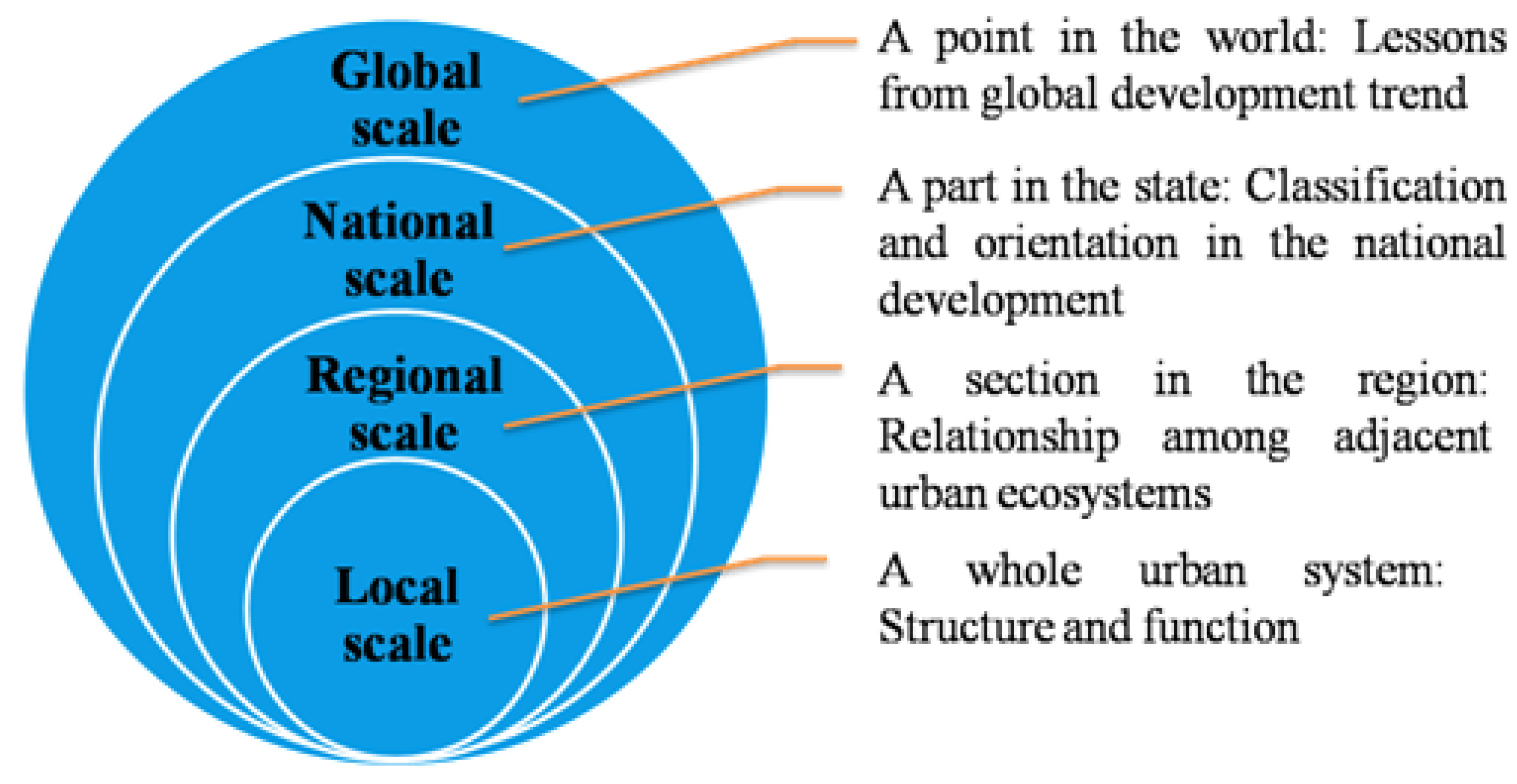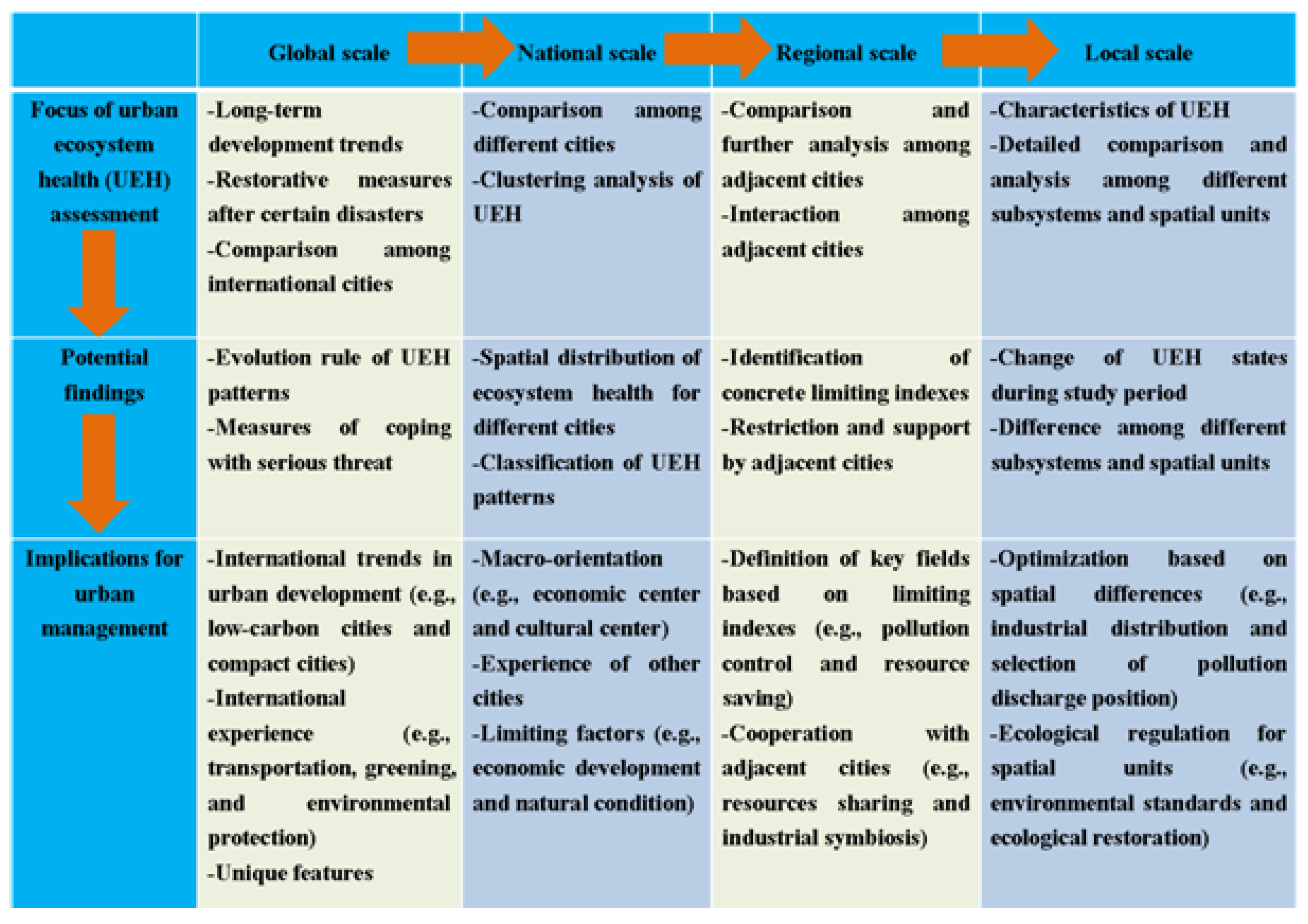Urban Ecosystem Health Assessment and Its Application in Management: A Multi-Scale Perspective
Abstract
:1. Introduction
2. Factors of Concern for Urban Ecosystem Health

3. Multi-Layer Roles of Urban Ecosystems

4. Multi-Scale Urban Ecosystem Health Assessment and Its Applications in Management

5. Case Study
| Scale | Global scale | National scale |
| Results of urban ecosystem health assessment | Environmental quality is the main constraint of urban performance, especially as the air quality is low [27]. | Guangzhou and other Chinese cities like Beijing, Tianjin, and Shanghai, with relative weak health levels, are classified in the same group.Their common characteristics include high urbanization, high industrialization, and high environmental impacts. The latter is the main restriction of health levels [12]. |
| Implications for management | Measures aiming at creatinga green city, eco-city, compact city, and low-carbon city in international cities are useful reference points. Holistic regulation of land use, public transportation, energy and resource efficiency, and waste treatment need be implemented. | As a regional economic center, various activities arelikely to be intensified, supported by dense energy and flow of resources. Means of using energy and resourcesefficiently should be established to pursue harmony between economic development and environmental protection. |
| Scale | Regional scale | Local scale |
| Results of urban ecosystem health assessment | Concrete indicators related to environmental impact are compared for Guangzhou and other cities in the Pearl River Delta. The limiting factors of Guangzhou are identified aslimited local renewable energy sources, small carrying capacity, high dependence on imported energy and resources, and large amounts of waste [28]. | The spatial distribution of health levelsin Guangzhou is revealed.The north of Guangzhou is defined as a conservation area, the middle and southern parts are defined as maintenance areas, while the south central and southwestern parts are defined as key regulation areas [29]. |
| Implications for management | In order to slow down the rate of energy depletion and reduce dependence on imports, relevant energy policy and efficient energy usage needs to be proposed [30]. Measures on population control and waste treatment should be strengthened to enlarge the carrying capacity. Cooperation among adjacent cities should be conducted to construct a circular economic chain and realize the optimized cost-benefit budget. | Zoning management should be implemented. Natural resources should be protected and human activities limited in northern parts of the region. Measures to improve economic productivity and energy efficiency, and maintain indigenous renewable resources should be implemented in middle and southern parts of the region. For south central and southwestern parts, more space should be allocated for environmental-friendly production, green consumption patterns should be promoted, energy demands should be reduced, and waste discharge should be reduced. |
6. Discussion and Conclusions
Acknowledgments
References
- Vitousek, P.M.; Mooney, H.A.; Lubchenco, J.; Melillo, J.M. Human dominance of Earth’s ecosystems. Science 1997, 277, 494–499. [Google Scholar] [CrossRef]
- O’Laughlin, J. Forest ecosystem health assessment issues: Definition, measurement, and management implications. Ecosyst. Health 1996, 2, 19–39. [Google Scholar]
- Rapport, D.J.; Böhm, G.; Buckingham, D.; Cairns, J., Jr.; Costanza, R.; Karr, J.R.; de Kruijf, H.A.M.; Levins, R.; McMichael, A.J.; Nielsen, N.O.; et al. Ecosystem health: The concept, the ISEH, and the important tasks ahead. Ecosyst. Health 1999, 5, 82–90. [Google Scholar] [CrossRef]
- Harpham, T. Urban health in the Gambia: A review. HealthPlace 1996, 2, 45–49. [Google Scholar] [CrossRef]
- Takano, T.; Nakamura, K. An analysis of health levels and various indicators of urban environments for Healthy Cities projects. J. Epidemiol. Commun. Health 2001, 55, 263–270. [Google Scholar] [CrossRef]
- Guo, X.R.; Yang, J.R.; Mao, X.Q. Primary studies on urban ecosystem health assessment (in Chinese). China Environ. Sci. 2002, 22, 525–529. [Google Scholar]
- Su, M.R.; Yang, Z.F.; Chen, B.; Ulgiati, S. Urban ecosystem health assessment based on emergy and set pair analysis—A comparative study of typical Chinese cities. Ecol. Model 2009, 220, 2341–2348. [Google Scholar] [CrossRef]
- Spiegel, J.M.; Bonet, M.; Yassi, A.; Molina, E.; Concepcion, M.; Mast, P. Developing ecosystem health indicators in centro Habana: A community-based approach. Ecosyst. Health 2001, 7, 15–26. [Google Scholar] [CrossRef]
- Zhou, W.H.; Wang, R.S. An entropy weight approach on the fuzzy synthetic assessment of Beijing urban ecosystem health, China (in Chinese). Acta Ecologica. Sinica. 2005, 25, 1344–1351. [Google Scholar]
- Yan, W.T. Research on urban ecosystem health attribute synthetic assessment model and application (in Chinese). Syst. Eng. Theor. Practice 2007, 8, 137–145. [Google Scholar]
- Su, M.R.; Yang, Z.F.; Chen, B. Relative urban ecosystem health assessment: A method integrating comprehensive evaluation and detailed analysis. Ecohealth 2010, 7, 459–472. [Google Scholar] [CrossRef] [PubMed]
- Liu, G.Y.; Yang, Z.F.; Chen, B.; Ulgiati, S. Emergy-based urban health evaluation and development pattern analysis. Ecol. Model 2009, 220, 2291–2301. [Google Scholar] [CrossRef]
- Müller, F.; Lenz, R. Ecological indicator: Theoretical fundamentals of consistent applications in environmental management. Ecol. Indic. 2006, 6, 1–5. [Google Scholar] [CrossRef]
- Costanza, R.; Norton, B.G.; Haskell, B.D. Ecosystem Health: New Goals for Environmental Management, 1st ed.; Island Press: Washington, DC, USA, 1992. [Google Scholar]
- Odum, E.P. Perturbation theory and the subsidy-stress gradient. Bioscience 1979, 29, 349–352. [Google Scholar] [CrossRef]
- Karr, J.R.; Fausch, K.D.; Angermeier, P.L.; Yant, P.R.; Schlosser, I.J. Assessing Biological Integrity in Running Waters: A Method and Its Rationale, 1st ed.; Illinois Natural History Survey: Champaign, State, USA, 1986. [Google Scholar]
- Rapport, D.J. What constitute ecosystem health? Perspect. Biol. Med. 1989, 33, 120–132. [Google Scholar] [CrossRef]
- Mageau, M.T.; Costanza, R.; Ulanowicz, R.E. The development and initial testing of a quantitative assessment of ecosystem health. Ecosyst. Health 1995, 1, 201–213. [Google Scholar]
- Odum, E.P. Ecology and Our Endangered Life-support Systems, 1st ed.; Sinauer Associates: Sunderland, State, USA, 1989. [Google Scholar]
- Su, M.R.; Fath, B.D.; Yang, Z.F. Urban ecosystem health assessment: A review. Sci. Total Environ. 2010, 408, 2425–2434. [Google Scholar] [CrossRef] [PubMed]
- Ramalho, C.E.; Hobbs, R.J. Time for a change: Dynamic urban ecology. Trends Ecol. Evol. 2012, 27, 179–188. [Google Scholar] [CrossRef] [PubMed]
- Brenner, N. Beyond state-centrism? Space, territoriality, and geographical scale in globalization studies. Theor. Soc. 1999, 28, 39–71. [Google Scholar] [CrossRef]
- Sassen, S.; Dotan, N. Delegating, not returning, to the biosphere: How to use the multi-scalar and ecological properties of cities. Global Environ. Chang. 2011, 21, 823–834. [Google Scholar] [CrossRef]
- Cai, Y.P.; Huang, G.H.; Tan, Q.; Liu, L. An integrated approach for climate-change impact analysis and adaptation planning under multi-level uncertainties. Part II: Case study. Renew. Sust. Energ. Rev. 2011, 15, 3051–3073. [Google Scholar] [CrossRef]
- Mauro, S.E.D. Seeing the local in the global: Political ecologies, world-systems, and the question of scale. Geoforum 2009, 40, 116–125. [Google Scholar] [CrossRef]
- Guangzhou Municipal Statistics Bureau. Guangzhou Statistical Yearbook 2011 (in Chinese). Available online: http://data.gzstats.gov.cn/gzStat1/chaxun/njsj.jsp (accessed on 6 November 2012).
- Wang, J.; Su, M.R.; Chen, B.; Chen, S.Q.; Liang, C. A comparative study of Beijing and three global cities: A perspective on urban livability. Front. Earth Sci. 2011, 5, 323–329. [Google Scholar] [CrossRef]
- Su, M.R.; Yang, Z.F.; Chen, B. Limiting factor analysis of urban ecosystems based on emergy—A case study of three cities in the Pearl River Delta in China. Procedia. Environ. Sci. 2011, 5, 131–138. [Google Scholar] [CrossRef]
- Su, M.R.; Fath, B.D. Spatial distribution of urban ecosystem health in Guangzhou, China. Ecol. Indic. 2012, 15, 122–130. [Google Scholar] [CrossRef]
- Donoso, P.; de Grange, L. A microeconomic interpretation of the maximum entropy estimator of multinomial logit models and its equivalence to the maximum likelihood estimator. Entropy 2010, 12, 2077–2084. [Google Scholar] [CrossRef]
- Smajgl, A.; House, A.P.N.; Butler, J.R.A. Implications of ecological data constraints for integrated policy and livelihoods modelling: An example from East Kalimantan, Indonesia. Ecol. Model. 2011, 222, 888–896. [Google Scholar] [CrossRef]
- Cai, Y.P.; Huang, G.H.; Tan, Q. An inexact optimization model for regional energy systems planning in the mixed stochastic and fuzzy environment. Int. J. Energ. Res. 2009, 33, 443–468. [Google Scholar] [CrossRef]
- Tan, Q.; Huang, G.H.; Cai, Y.P. Waste management with recourse: An inexact dynamic programming model containing fuzzy boundary intervals in objectives and constraints. J. Environ. Manage. 2010, 91, 1898–1913. [Google Scholar] [CrossRef] [PubMed]
- Tan, Q.; Huang, G.H.; Wu, C.Z.; Cai, Y.P.; Yan, X.P. Development of an inexact fuzzy robust programming model for integrated evacuation management under uncertainty. J. Urban. Plan D ASCE 2009, 135, 39–49. [Google Scholar] [CrossRef]
© 2013 by the authors; licensee MDPI, Basel, Switzerland. This article is an open access article distributed under the terms and conditions of the Creative Commons Attribution license (http://creativecommons.org/licenses/by/3.0/).
Share and Cite
Su, M.; Yang, Z.; Chen, B.; Liu, G.; Zhang, Y.; Zhang, L.; Xu, L.; Zhao, Y. Urban Ecosystem Health Assessment and Its Application in Management: A Multi-Scale Perspective. Entropy 2013, 15, 1-9. https://doi.org/10.3390/e15010001
Su M, Yang Z, Chen B, Liu G, Zhang Y, Zhang L, Xu L, Zhao Y. Urban Ecosystem Health Assessment and Its Application in Management: A Multi-Scale Perspective. Entropy. 2013; 15(1):1-9. https://doi.org/10.3390/e15010001
Chicago/Turabian StyleSu, Meirong, Zhifeng Yang, Bin Chen, Gengyuan Liu, Yan Zhang, Lixiao Zhang, Linyu Xu, and Yanwei Zhao. 2013. "Urban Ecosystem Health Assessment and Its Application in Management: A Multi-Scale Perspective" Entropy 15, no. 1: 1-9. https://doi.org/10.3390/e15010001





